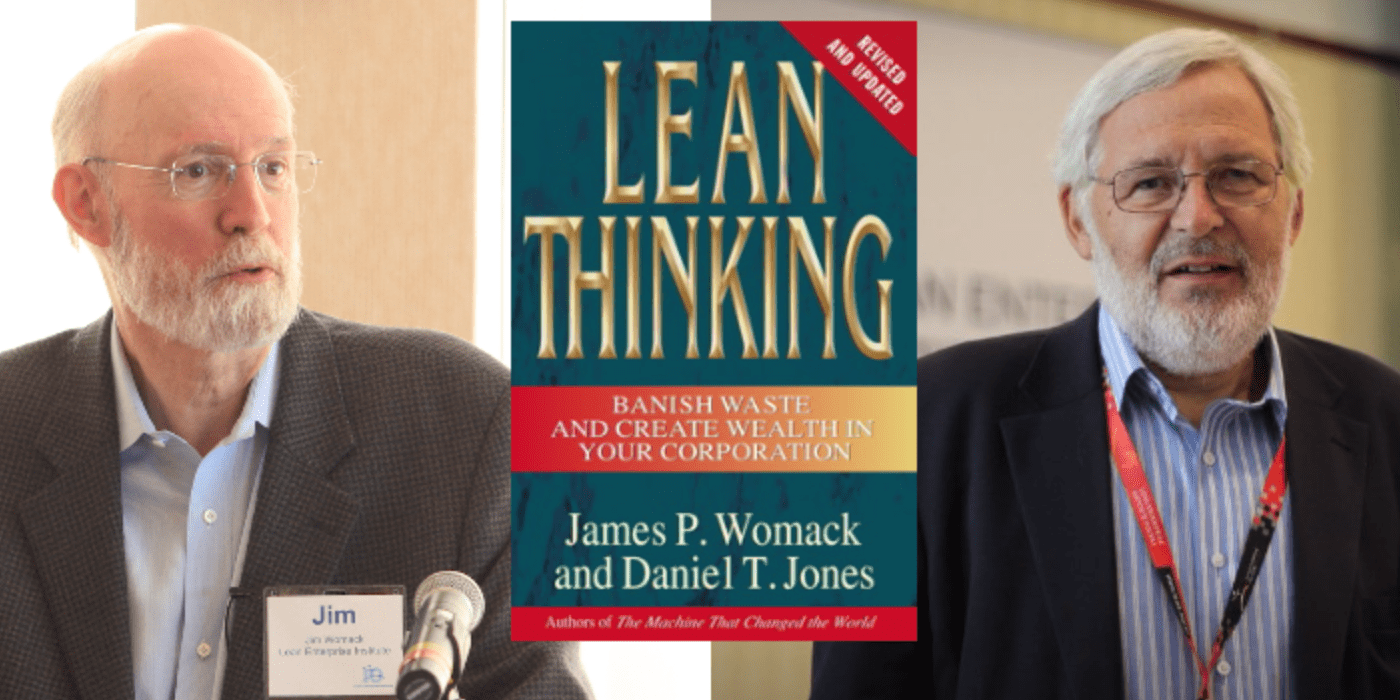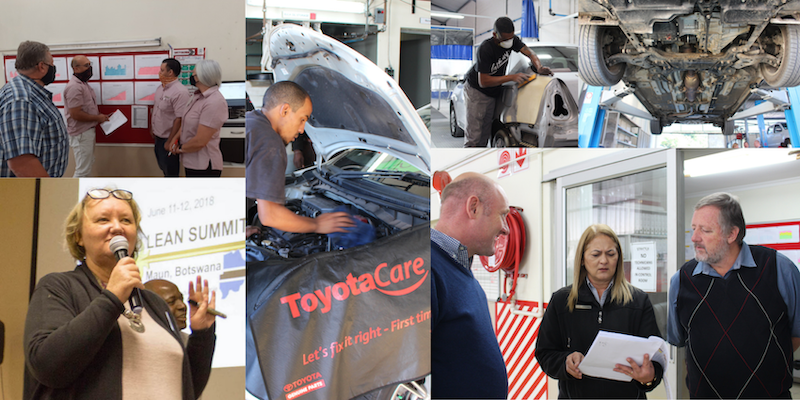
What is your theory of success?
FEATURE – To successfully transform, we need to change our “theory of success”. The authors discuss the obstacles managers face along the way.
Words: Michael Ballé, Eivind Reke and Caroline Sauvegrain
“All my colleagues now drive Toyotas as well,” said the taxi driver on a recent trip, “because every other brand’s quality has gone to hell.” Indeed, every taxi in town seems to be either a Toyota or a Lexus. Sure enough, in 2023 Toyota continues to be the top automaker in the world for the fourth consecutive year, with steady earnings and revenues. A plot of Toyota versus GM global unit sales over the past two decades looks something like this:

You’d think this is bound to raise a few eyebrows, but most leaders we show this to simply shrug it off. After all, it’s known to everyone that Toyota has a wider line-up than GM and keeps making cars for every market segment while retaining a strong focus on quality. And that GM is run by financial managers who focus on the most profitable segments and decide every quarter what must be done to make the numbers is also old news. When we invite leaders to look at their own numbers, and at their leadership attitudes and behaviors, and ask them if they “are a GM or a Toyota,”we are met with embarrassed silence.
After they master some courage, they commonly say things like: “But it’s not the same for us. We need to run the business according to budget. We don’t make cars. And in any case, enough about Toyota – look at Tesla. Toyota is lagging in the full electric race – they’re going to disappear soon.”
Why aren’t senior leaders keener on adopting a Toyota-style lean strategy and instead continue to hang on tightly to their GM-style losing strategy year after year? This is a puzzle that has all left us stumped for a long time. No amount of evidence or experience seems to make a dent into corporate thinking: traditional leaders believe they need to start from financial targets to satisfy the board, the stock market, the owners, etc (curiously, never the customers) and then break down those targets into budgets, with clear objectives for each department, incentivize managers on reaching these objectives, and then… see what happens. Mid-year, if things are not working out as hoped for, they tell managers to do what it takes to get back on target.
In this finance worldview, the top line - revenue - is magic: it grows yearly because customers continue to purchase. Nobody understands why or how, but it’s a basic assumption. Companies also measure, break down and control operational costs to be more profitable. Then, of course, nothing works out as planned, but that’s okay: they can explain it all away as exceptional costs (how could we have known a poorly maintained oil platform could suddenly burn and spill oil all over the coast?) and in any case, the real cash is in financial profits and losses – the company itself is the product. Bottom line only matters to put a price tag on the business as a whole.
In the lean world, the top line is driven by customers’ perception of value: what do they get for the money they pay. Revenue is built day by day by offering value to one customer after another. Bottom line is the results of somehow being convincing to customers whilst controlling total costs. Budgets are tools, not guidelines. What really matters is value.
When Jim Womack and Dan Jones wrote Lean Thinking, they hit the issue square on the nose: it’s a problem of thinking. How you think about your business – or refuse to do so – makes all the difference to how your management teams run it day after day. So, if senior leaders don’t step into the lean room (despite both evidence and experience telling them they should), we need to better understand what is keeping them out.
TAKT TIME
You can’t think lean if you don’t think takt time. Rather than start with how much revenue you generate monthly, ask yourself what deliverable you need to deliver and at what rhythm. Most people stop there. They believe takt time doesn’t apply to their service, made-to-order business. But takt time always applies: it’s a calculation - open time divided by customer demand. But what does it mean in your context? For instance, say that your business is coaching company leaders: how can takt time apply? Well, your deliverable is gemba walks. Your open time is up to you, say 10 days a month. If you agree that to be effective you need roughly 10 gemba walks a year (that is the value proposition), with a demand of four leaders, it’s a gemba walk every two calendar days or so.
Clearly, it’s not a “takt time” like you’d compute on a production line, yet it is a clear rhythm. This is very different from thinking, “I need to sell two five-day workshops” to each company to reach my target of 40 billable days a year.
Thinking takt time leads you to ask very different questions, such as:
- Why should any leader show up at the next gemba walk after this one?
- Am I organized to keep up that rhythm today?
- How can I both maintain my skills and innovate to be interesting next year?
OK OR NOT-OK
Thinking in terms of deliverables at takt time, which one can visualize as kanban cards, gets you to ask yourself a fundamental question: why would the next customer purchase one as well? The plan is to build every so many minutes, hours, days, etc. But the second part of the plan is to only make one when one has been sold. In this way, the gap to plan appears immediately.
Why would the next customer buy one? We’re not talking market segments and sales projections here. We’re talking value: how can we tell an OK product from a not-OK one? This is the second hurdle making most senior managers shy away from lean. How could they know? For every product on the line-up? For every customer? In this, founders differ from professional managers because at some time in their life, in order to survive, they had to figure out the difference between a good sale and a bad sale. But even founders start running the company and get out of touch with these basic questions. Look at your deliverable and ask yourself the following. In today’s context, for each customer:
- What problem(s) does this product/service solve for this customer?
- Does it solve it well or poorly?
- At what price and does the customer see the value?
Then you can look at your delivery process and ask yourself:
- Is this process going to solve the customer’s problem?
- What are green (all OK) and red (something not-OK) zones for this process?
- How much does it cost to run: variable costs AND fixed costs? How much cash does it consume?
Which leads into looking forward:
- Is my organization currently focused on keeping processes in the green?
- Is it focused on keeping processes in the green in the future?
- Where does it need to deliver new products/processes? With cash coming from where?
Quality thinking is radical because it leads into concrete decision-making. Distinguishing OK from not-OK is the key to knowing what decisions to make and what action to take as a consequence:
- The product has one not-OK aspect: do I ship or not? If I don’t (good answer), how do I deal with this right away? What do I tell the customer? How do I compensate? How do I fix the issue short term? Where the hell did the problem come from?
- The process has one not-OK aspect: is in the red or just orange (or even green – normal cost of doing business)? Do I keep producing or stop everything (good answer)? If I stop, what happens to delivery? How fast can I fix this short term and get back into green? How did the process drift into failure? What must we do about that?
- The organization supports one not-OK process: is that the normal state of an organization or is that a crisis? How can this be dealt with short term? What are the implications for our future business? How can we correct this? What budget do we allocate to correct it? Or should we take a whole new process?
Toyota remains one of the rare organizations to recognize that quality is the ultimate source of cost control: first, customers won’t purchase poor quality products twice; secondly, quality achieved through rework is costly and requires more capital than necessary; and thirdly, accepting low quality work as opposed to stopping immediately and correcting it leads to poor overall decision making.
Obsessing about quality makes you face two decisions daily: how can I tell OK from not-OK in any product and in any process? Am I making quality decisions (continue or stop) today? How much am I investing in the right people and conditions to make sure quality decision-making is at the forefront of everyone’s thinking?
PEOPLE ENGAGEMENT AND MORALE
For each kanban card of a deliverable, at every takt, is the person doing the work fully engaged in doing it as best she can? Is she in high or low spirits? Does she believe in what she does? In the usefulness of her job, in the chumminess of her teammates, in the rightfulness of her company and the competence and fairness of its managers? Company leaders are usually willing to carry out employee satisfaction surveys and most of them (although by all means not all) realize that morale matters to performance, somewhere along the line. But they firmly believe that morale is a matter of incentives and systems.
A third, immense obstacle to Lean Thinking is to have team leaders run a value stream. As the late Toyota veteran Takehiko Harada told us, the team leader position arose from Taiichi Ohno’s determination to drive kaizen. Ohno sought “logic escape” from every cell – pushing operators and supervisors to think differently to find different ways to do things. Team members most active on kaizen became the first team leaders: one per every five- to six-people team to keep the team improving. To be fair, even mighty Toyota struggles with keeping the kaizen spirit alive. In the last Toyota plant one of us visited in Asia, because of recruitment difficulties, team leaders were doing more line work than expected and so kaizen was weak.
Mission-oriented outfits, from Toyota to the US Marines, recognize team members need three things to keep their spirits high: individual progress through obstacles, safety and support from their team, and recognition from their organization.

Team leaders are the key to providing both engagement and motivation by recognizing the cells’ true potential – their best performing day applied to the rest of the year – and encouraging and supporting the team to reach for their best every day, by being aware of problems, solving them and constantly training and retraining to master changes and new tech. The main tool to do so is kaizen: the recognition of small-step initiatives to either solve problems or come up with improvement ideas.
Senior leaders are usually comfortable with the system – making people learn and follow standardized work and other procedures. They are far less comfortable with the chaos (limited chaos to be sure) around kaizen, small-step improvements that nonetheless require constant change.
VISUALIZATION
“Lean” tools and techniques are essentially visualizations of these core ideas in order to orient and support each team to continue to strive for greater quality and sustain a culture of success (success matters, failure is not acceptable) as opposed to the culture of failure financial management creates (nothing matters other than share price, failure is unavoidable and can always be explained). Success is achieved by relentless efforts to progress through learning, the only way adults know how:
- Orient and plan your next step
- Visualize it
- Do it
- Debrief and learn from what work and what didn’t through Genchi Genbutsu
The Toyota Production System we call “lean” is a set of standard techniques for step 2, from kanban to andon to standardized work sheets analysis to MIFA to A3 to ringi, and so on.
Applying these visualization tools without understanding the underlying worldview twists their interpretation in reinforcing the traditional outlook of doing things for cost savings rather than for building value for customers and, not surprisingly, ends up in further failure. Obviously, success is harder than failure and the Toyota way rests on an individual awareness of problems and efforts to overcome it, what it calls human capital. A human capital development process is a one-to-one effort, not the one-to-many that mainstream management typically follows.
The human capital development mostly happens on the gemba in the form of Genchi Genbutsu, the leadership practice of going to the process yourself to validate what is being presented in reports, meetings, emails, team chats, and the endless array of new communication tools available. It’s a skillset that needs training, honing and maintenance. However, the ability to understand when a process is not working as it should is fundamental to break through the logic of excuses and explanations usually served when things are failing. Going to the gemba is about distinguishing facts from data – and getting people to agree on the problem before debating solutions. Without a deep, hands-on, concrete understanding of problems and seeing what local countermeasures people look for, all solutions miss their mark.
With financial management, leadership looks at a handful of strategic scenarios, and chooses the most banal (the fad of the moment and usually what every competitor is doing) and defines mid-term “strategic” objectives with the corresponding changes which, taken as a whole, become a “transformation.” Each of these changes come with an action plan and all of this is to better format the business to convince analysts and support the share price – no one worries much that this is like driving a car looking at the rear mirror. In the meantime, every crisis on the market is the opportunity to reduce the company’s capability for future sales – convincing future customers to purchase the product or service. Management is absolutely certain they’re doing everything right (or that they have no choice) while they weaken their business as they respond to every event by correcting the ratios – not worrying about customers, people, or suppliers. Even innovation no longer means solving new customer problems (or solving old problems better) with new tech; instead, it has become “we need to invest in this because the market expects us to.”
The gateway to Lean Thinking and seeking Toyota’s enduring success (until reversal to the mean happens and Toyota starts promoting MBAs as well) is to overcome four cognitive hurdles: calculate takt time for your business; understand what is a good, average and bad product on your market, and a good, average, bad technical process to deliver it; make sure you’ve got your people engaged with high morale by developing a robust population of team leaders (and creating the organization needed to do so); and, last but not least, see your suppliers as a value network to develop for your future success rather than a supply chain to milk for next quarter’s profits.
We may believe what we see but we also see what we believe. Our theory of success has a disproportionate impact on how we go about things and react to events. Toyota’s theory of success is clear and explicit: make customers happy one by one by offering them the next car they want (with a wide, non-cannibalized line-up), provide them with quality products and develop human capital by not allowing non-quality or stagnation to accumulate in your process, which allows all to focus on value: improving quality whilst reducing costs. The financial theory of success is equally clear: treat the company as a financial product, aim to get key ratios as you want them, express this in “must win” battles with objectives and action plans and make sure people follow through with budget control, endless indicators and process standardization. Unless you are sitting on a gushing oil well and customers are desperate to get their hands on your product, we know that this second theory doesn’t lead to success but to plateau-ing and then retrenching as you’re hit by external crises until you’re refinanced or sold.
All this is known. However, our theories of success are not ours alone. They are transmitted by our seniors and supported by our peers. True transformation is a personal transformation when we have the foresight and the grit to change our own theory of success and then build awareness around us, which, unfortunately, is a one-on-one job: one person at a time. By visualizing more clearly the hurdles that stop a senior manager from entering the lean room, we believe that we can help them be more rational about their strategic choices and commit to explore, experiment and experience the lean strategy in order to find lean success and, together, build a better, waste-free society.
THE AUTHORS



Read more


FEATURE – Lean book clubs as a way to boost learning and collaboration. A Norwegian firm that has been using them for a decade gives us a few tips on how to make them successful.


INTERVIEW – Twenty years ago a book started a movement that is growing stronger every day and that has changed the world in many ways. We caught up with the authors to sneak a peek behind the scenes.


FEATURE – In the Shatila camp south of Beirut, a self-help program is making a difference in the lives of Palestinian refugees, engaging them in rehabilitating their shelters.


FEATURE - Projects or programs? The authors discuss why Lean Thinking should go beyond piecemeal operational improvements, as a transformative strategy that balances today’s demands with future adaptiveness.
Read more


NOTES FROM THE GEMBA – By introducing flow in its processes and transforming its approach to managing the business, this French manufacturer of fences and gates is building a competitive advantage.


FEATURE – In this compelling theoretical piece, the author reminds us how in a lean organization relations are structured around learning opportunities rather than execution. This is what ultimately enables a company to grow.


INTERVIEW – One of the world's largest dairy cooperatives, FrieslandCampina, has embarked on an ambitious global lean journey. Along the way, they found how critical leadership engagement is.


FEATURE – Hansei is a powerful tool that helps us understand Lean Thinking and advance on our journey. The author shares the lessons he learned from the struggles Halfway Toyota encountered during its years-long transformation.

